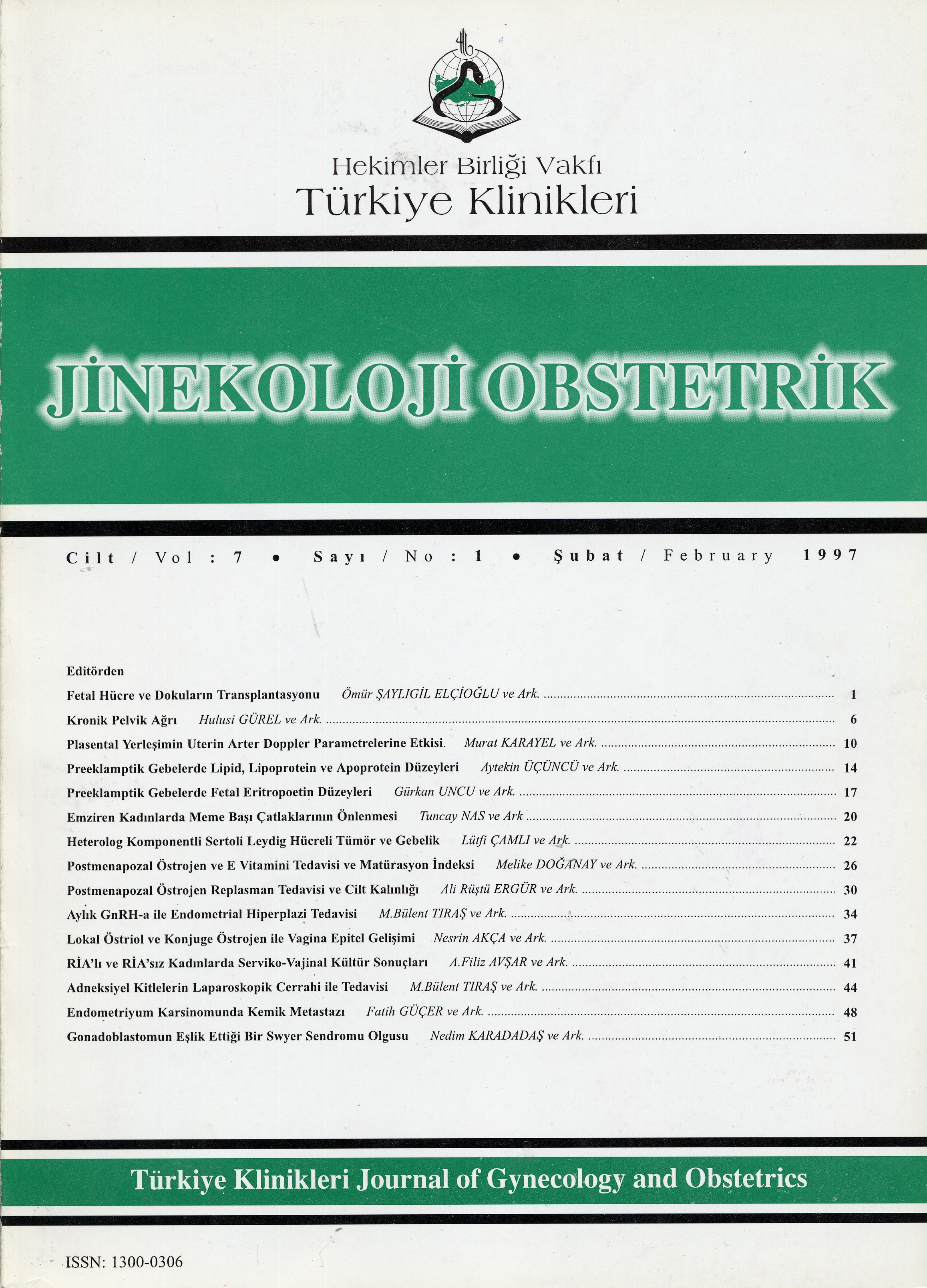Open Access
Peer Reviewed
ARTICLES
1615 Viewed886 Downloaded
Preeklamptik Gebelerde Lipid, Lipoprotein ve Apoprotein Düzeyleri
Preeklamptik Gebelerde Lipid, Lipoprotein ve Apoprotein Düzeyleri
Turkiye Klinikleri J Gynecol Obst. 1997;7(1):14-6
Article Language: TR
Copyright Ⓒ 2020 by Türkiye Klinikleri. This is an open access article under the CC BY-NC-ND license (http://creativecommons.org/licenses/by-nc-nd/4.0/)
ÖZET
Amaç: Normal ve preeklamptik gebelerde plazma lipid, lipoprotein ve apoprotein seviyelerindeki değişiklikleri değerlendirmek. Çalışmanın yapıldığı yer: KTÜ Tıp Fakültesi, Kadın Hastalıkları ve Doğum ile Biyokimya Anabilim Dalları. Materyel ve Metod: Bu prospektif klinik çalışma, 48 preeklamptik hasta ve sağlıklı 30 gebe kadından oluşan kontrol grubu olmak üzere toplam 78 gebe kadında yapıldı. Bunlarda, total kolesterol, trigliserid, HDL-C, LDL-C, Apo A-1, Apo B incelendi. Bulgular: Preeklamptik gebelerde, plazma total kolesterol ve total trigliseriddeki artış, HDL-C ve Apo B'deki azalma istatistiksel olarak anlamlı bulundu (p<0.05). Sonuç: Preeklamptik gebelerde, ateroskleroz ve tromboz gelişimine sebep olabileceği düşünülen, plazma lipid, lipoprotein ve apoprotein düzeylerinde değişiklik meydana gelmektedir.
Amaç: Normal ve preeklamptik gebelerde plazma lipid, lipoprotein ve apoprotein seviyelerindeki değişiklikleri değerlendirmek. Çalışmanın yapıldığı yer: KTÜ Tıp Fakültesi, Kadın Hastalıkları ve Doğum ile Biyokimya Anabilim Dalları. Materyel ve Metod: Bu prospektif klinik çalışma, 48 preeklamptik hasta ve sağlıklı 30 gebe kadından oluşan kontrol grubu olmak üzere toplam 78 gebe kadında yapıldı. Bunlarda, total kolesterol, trigliserid, HDL-C, LDL-C, Apo A-1, Apo B incelendi. Bulgular: Preeklamptik gebelerde, plazma total kolesterol ve total trigliseriddeki artış, HDL-C ve Apo B'deki azalma istatistiksel olarak anlamlı bulundu (p<0.05). Sonuç: Preeklamptik gebelerde, ateroskleroz ve tromboz gelişimine sebep olabileceği düşünülen, plazma lipid, lipoprotein ve apoprotein düzeylerinde değişiklik meydana gelmektedir.
ANAHTAR KELİMELER: Preeklampsi, Lipid, Lipoprotein, Apoprotein
ABSTRACT
Objective: In this study our purpose is to evaluate the levels of lipid, lipoprotein and apoprotein in normal and preeclamptic pregnants. Institution: Karadeniz Technical University, Faculty of Medicine, The Department of Gynecology and Obstetrics. Material and Methods: This study had been performed in a group of 78 pregnant women, which 48 were preeclamptic and 30 were normal. The plasma levels of total cholesterol, trigliserid, HDL cholesterol, LDL cholesterol, Apo A-1 and Apo B were evaluated. Results: The increase of total cholesterol and total trigliserid and the decrease of HDL-C and Apo B in the preeclamptic group was istatistically significant (p<0.05). Conclusion: Preeclamptic pregnants show some changes in plasma lipid, lipoprotein and apoprotein levels which may result in atherosclerosis and thrombosis.
Objective: In this study our purpose is to evaluate the levels of lipid, lipoprotein and apoprotein in normal and preeclamptic pregnants. Institution: Karadeniz Technical University, Faculty of Medicine, The Department of Gynecology and Obstetrics. Material and Methods: This study had been performed in a group of 78 pregnant women, which 48 were preeclamptic and 30 were normal. The plasma levels of total cholesterol, trigliserid, HDL cholesterol, LDL cholesterol, Apo A-1 and Apo B were evaluated. Results: The increase of total cholesterol and total trigliserid and the decrease of HDL-C and Apo B in the preeclamptic group was istatistically significant (p<0.05). Conclusion: Preeclamptic pregnants show some changes in plasma lipid, lipoprotein and apoprotein levels which may result in atherosclerosis and thrombosis.
MENU
POPULAR ARTICLES
MOST DOWNLOADED ARTICLES





This journal is licensed under a Creative Commons Attribution-NonCommercial-NoDerivatives 4.0 International License.











